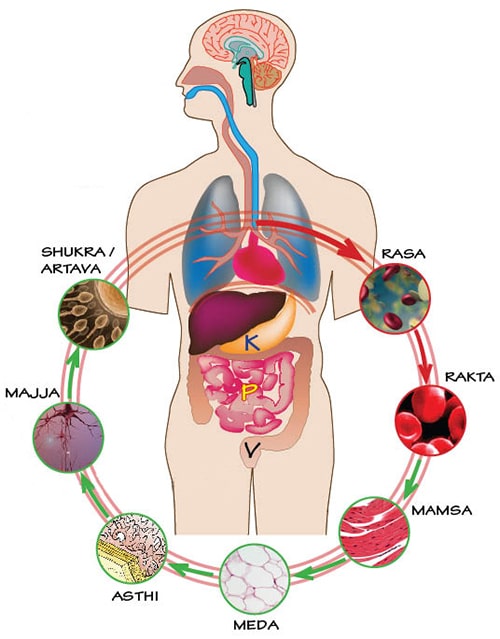
Overview
From Anatomy point of view, dhatu refers to tissue. In Rasa Shastra, dhatu stands for the minerals. The seven tissues or more precisely, dhatus are important from anatomical point of view. They are rasa, rakta, mamsa, medas, asthi, majja and shukra. From human anatomy point of view, they are better described as plasma, blood, muscle, fat or adipose tissue, bone, bone-marrow and seminal fluid. Basic understanding of dhatus is vital to understand the underlying pathology of the disease. When a dosha or biological humour enters a particular dhatu, a genuine understanding of the tissue or the dhatu helps the Ayurvedic practitioner for prediction of the symptoms of the diseases. It is helpful in providing hint to the best possible treatment.
According to Ayurvedic system of medicine, the seven dhatus are chiefly responsible for the immunity. Ayurvedic system of medicine follows a very rational and specific method for treatment of diseases having relation to the particular dhatus. The growth and existence of the human body is dependent on these seven dhatus. These seven dhatus are composed of five elements or panchmahabhutas. When there is an imbalance or disequilibrium in functioning of the dhatus, the result is the manifestation of the disease.
Formation of the dhatus
When the food we eat is digested and is converted into three portions:
The gross undigested food is converted into waste products (faeces);The middle is converted in one of the tissues or Dhatus,The subtlest form gets converted into ojasa (sara of the seven dhatu) or the immunity.
As per rule and regulation, food we eat is firstly converted into Rasa. Once there is formation of Rasa, the remaining gets converted into Rakta. Once there is formation of Rakta, the remaining gets converted into Mamsa. Once there is formation of Mamsa, the remaining gets converted into Meda. Once there is formation of Meda, the remaining gets converted into Asthi. Once formation of Asthi is over, the remained gets converted into Majja. Once there is formation of Majja, the remaining gets converted into Shukra.
Dhatvagni
All the seven element tissues of the body contains their own Agni to metabolize the nutrients supplied to them through channels of circulation.
- Rasagni in the Rasa Dhatu or plasma
- Raktagni in the Rakta Dhatu or blood
- Mamsagni in the Mamsa Dhatu or muslce
- Medagni in the Meda Dhatu or fat
- Asthyagni in the Asthi Dhatu or bone
- Majjagni in the Majja Dhatu or bone-marrow
- Shukragni in the Shukra Dhatu or reproductive fluid.
Rasa-Plasma
According to Ayurvedic system of medicine, rasa represents the first dhatu. Rasa is the major and primary constituent of the human body. Rasa represents the fluids (extra cellular and intracellular parts) of the human body and it mainly concerned with nourishment and strengthening the blood. Once the process of digestion of the food is complete, it gets converted into a liquid (chyle) which undergoes transformed into blood tissue.
Rakta-Blood
When the rasa or plasma undergoes refining, then it is known as rakta dhatu (blood tissue). Rakta dhatu is mainly concerned with nourishment of the body by carrying macro and micro-nutrients to the body-cells and tissues of the human body through the circulatory system or the blood vessels. Rakta dhatu is preserver of life and plays major role in gaseous exchange.
Mamsa-Muscles
Mamsa represents the muscle that enters into the constituents of the internal organs of the human body. Mamsa dhatu is derived from the rakta dhatu and constitutes the cover of structure and bone of the human-body.
Meda-Fat
Meda tissue represents the adipose tissue or the fatty tissue. When the mamsa dhatu undergoes refining, then it is known as meda dhatu. Meda dhatu plays significant role in lubrication of the body parts. Meda dhatu is also important constituent of the brain, nervous tissue and the spinal cord. Most importantly, Meda dhatu is helpful in the maintenance of the internal body temperature.
Asthi-Bone
When the meda dhatu undergoes refining, then it is known as asthi- dhatu. The Asthi dhatu is mainly concerned with the basic structure to the human body. Asthi dhatu includes all the cartilaginous components in the human body.
Majja-Bone marrow
When the asthi dhatu undergoes refining, then it is known as majja-dhatu. The Majja dhatu is known as myeloid tissue. Myeloid tissue either takes the yellow or red colour. Myeloid tissue stay within the bone cavity also found inside the spinal cord and the brain.
Shukra-Reproductive fluid or Semen
Skukra-dhatu is chiefly responsible for the reproductive capacity of the human body. In fact, skukra-dhatu is most refined product of all the preceding dhatus. In males, it is known as sukra (includes the sperm). In females, it is known as sronita (includes the ovum).
Ojas
When all the dhatu undergoes refining, then it is known as ojasa. It is also known as mahadhatu.
